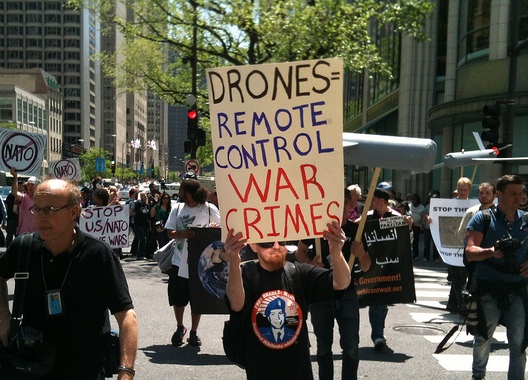 As Mark Bowden discusses in this month’s Atlantic cover story, there is great debate about whether drone strikes should be a core component of the U.S. counterterrorism strategy. Of all the the arguments in favor, those those emphasizing effectiveness of signature strikes are particularly dubious. The term “signature strike” is used to distinguish strikes conducted against individuals who “match a pre-identified ‘signature’ of behavior that the U.S. links to militant activity,” rather than targeting a specific person. The United States should not allow signature strikes because the cost of these attacks far outweighs the potential benefit. Leaving aside significant concerns about the legality of such strikes, there are serious questions about the efficacy of this approach in undermining terrorist networks.
As Mark Bowden discusses in this month’s Atlantic cover story, there is great debate about whether drone strikes should be a core component of the U.S. counterterrorism strategy. Of all the the arguments in favor, those those emphasizing effectiveness of signature strikes are particularly dubious. The term “signature strike” is used to distinguish strikes conducted against individuals who “match a pre-identified ‘signature’ of behavior that the U.S. links to militant activity,” rather than targeting a specific person. The United States should not allow signature strikes because the cost of these attacks far outweighs the potential benefit. Leaving aside significant concerns about the legality of such strikes, there are serious questions about the efficacy of this approach in undermining terrorist networks.
The problem with signature strikes is that they open the door to a much higher incidence of civilian casualties–and this is where the danger lies. If the United States is choosing targets based on suspicious activity or proximity to other known-terrorists, this falls short of the threshold for drone strikes set by the Obama Administration, perpetuates a disastrous U.S. image in Yemen, and serves to invigorate the ranks of those groups the United States aims to disable.
In response to increasing criticism, President Obama outlined his counterterrorism policy in May 2013 with a speech at National Defense University. Obama noted that the U.S. will only act against “terrorists who pose a continuing and imminent threat to the American people, and when there are no other governments capable of effectively addressing the threat.” He did not, however, directly address the use of signature strikes, leaving open the prospect that they could be used in the ongoing fight against terrorism. This would be a mistake. In Pakistan and Afghanistan, extensive signature strikes sparked a significant increase in anti-American sentiment. After years of drone strikes, 74 percent of Pakistanis considered the U.S. an enemy by 2012 (up from 64 percent in 2009) according to a Pew Research Center poll. The White House authorized signature strikes for Yemen, but U.S. officials insist that they have not employed this tactic to date. If true, the incidence of civilian and non-combatant casualties in Yemen means that faulty intelligence and targeting failures are to blame, which is perhaps even more worrisome.
In waging the drone campaign, the United States occasionally hits precisely the wrong person. A U.S. strike in August 2012 supposedly killed three al-Qaeda militants in Yemen. Among the casualties, however, was an anti-Qaeda imam and a policeman he had brought along for protection. The imam was working to dismantle al-Qaeda in the Arabian Peninsula (AQAP), making him precisely the sort of local ally the U.S. desperately needs in a place like Yemen. Yemeni Nobel Prize laureate Tawakkul Karman warned that Yemeni tribal leaders in areas where civilians have been killed in drone strikes say that these attacks drive more Yemenis to turn against Washington. During his testimony to the Senate Judiciary Committee, Yemeni writer Farea al-Muslimi recounted an incident where the eldest son of a man killed by a drone joined AQAP because he identifies the U.S. as his father’s killer and wants revenge. As the deaths and injuries mount, dangerous anti-American sentiment grows. When drone strikes occur and non-combatants are killed, Yemenis lash out with protests demanding justice and accountability from the United States–which has not been forthcoming.
In a place like Yemen, although the American drone program is universally hated, many Yemenis will admit they would support targeted assassinations if there is clear intelligence that an individual is a senior operative within AQAP and plotting a specific and imminent act of terror against Americans. The problem with signature strikes is that they do not meet this threshold–not even remotely– and they open the door for the U.S. to make grievous targeting mistakes and be seen as taking sides in a domestic insurgency. Signature strikes target low-level militants who might be nasty characters, but they are not necessarily planning an imminent act of terror or hold a leadership position.
Beyond signature strikes, there is a more fundamental question that we should be asking–a question of overall strategy: is the current drone program achieving our national security objectives? It is not just civil libertarians and human rights advocates that are sounding the alarm; a group of 30 foreign policy experts sent a letter to President Obama in March 2013 calling for an end to the current drone strategy. Even senior retired members of the military, including General Stanley McChrystal, believe drone strikes are counterproductive because of the blowback they foment among the local population.
Targeted killings may eliminate key al-Qaeda leaders, but when civilians die along with them, these strikes ensure that a generation of Yemenis, Pakistanis, or Somalis will blame the U.S. for killing innocent community members, exacerbating America’s serious image problems abroad and creating a space for extremist ideology to take root. In short, the U.S. drone program not only undermines the long-term national security of the United States by fostering widespread anti-U.S. sentiment, it also undermines the legitimacy of the host country government, whose support the U.S. needs, and it provides fodder for jihadi rhetoric that strengthens the very groups the U.S. seeks to destroy.
This piece was originally published in The Atlantic on August 13, 2013.
